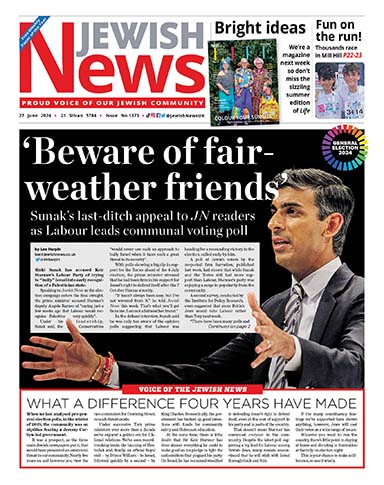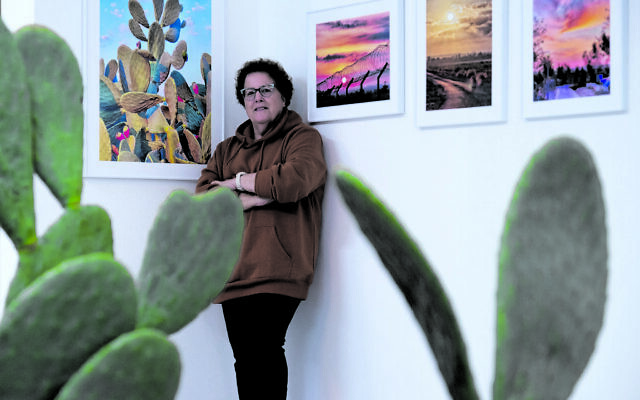SPECIAL REPORT: The peace campaigner who came to kill
Richard Ferrer reveals for the first time the full story of the Gazan who, after partnering with an Israeli on a peace project, arrived at her kibbutz on 7 October to murder her
Eight months before Machmud arrived at Batia Holin’s home to kill her, the two had jointly launched an exhibition aimed at promoting peace and unity between Israelis and Palestinians.
After connecting through a Facebook group for residents on the Israel-Gaza border, the pair spent months sharing pictures on WhatsApp of daily life from both sides of the fence. This seemingly heartfelt exchange blossomed into a poignant exhibition entitled Between Us, dedicated to bridging the divide. Due to the dire risks involved, they never spoke directly. ‘Normalisation’ (interacting with Jews) is the most serious crime a Gazan can commit.
“We didn’t discuss politics,” Batia tells me as we walk along the Gaza barrier fence on the outskirts of Kibbutz Kfar Aza, where Machmud – who told her he was a 28-year-old photographer from the Gazan town of Shuja’iyya – was one of 300 Hamas terrorists who breached the border on the morning of October 7 and entered her kibbutz.
The 71-year-old, who has lived on the kibbutz for more than 50 years, has dedicated her life to coexistence. The idea of collaborating with a Palestinian across the border, someone who experienced the same sights and sounds yet lived a vastly different reality, deeply resonated with her sense of purpose.
“Machmud and I wanted to show the world that, despite the circumstances in which we live, we share the same hope for a brighter future. That despite the obstacles, most people on both sides of the fence just want to live in peace.”
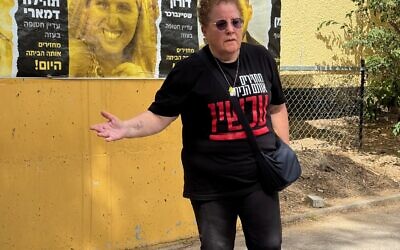
Their exhibition opened in Israel on 4 February 2023 in nearby Kibbutz Nahal Oz (where 14 people were killed and seven abducted), with plans for it to tour the United States. One of its most striking exhibits was photographs of the Mediterranean Sea, showing the same beach border from opposite perspectives: one looking north, the other south.
Machmud was, of course, unable to be there in person, so he wrote Batia a touching email: “I hope this project will influence and improve understanding, quality of life and security on both sides of the fence. I hope that with the help of my photos, Israeli society and the whole world will know that the Gaza Strip is not only a place of rockets and missiles but a place worth living in. I hope that with the help of my photos, Israeli society will see that in Gaza the people are simple, love life and are not fighters and terrorists. This exhibition, for me, is hope for a peaceful life.”
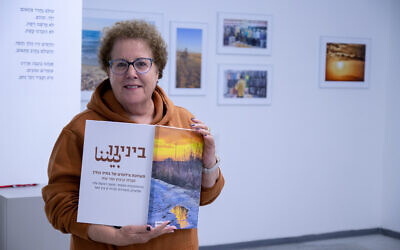
Today, in the wake of such unimaginable brutality, Batia’s dreams seem heartbreakingly naïve. Her faith has been so profoundly shattered that she fears there may not be a single adult in Gaza who shares her vision of peace. “The hardest feeling is the sense of total betrayal,” she tells me.
“The sense that everyone in Gaza was involved, even those who claim to oppose Hamas. I realise how awful that sounds. It truly is awful. But I cannot think anything else today. The past 17 years since Hamas took over Gaza have been difficult and it’s got worse over time. Before the attack, people called life here 90 percent heaven, 10 percent hell. Now it just feels like hell.”
Batia heard Machmud’s voice for the very first time at 10am on October 7 when she received a phone call from an Israeli number she did not recognise. He told her he was inside the kibbutz and asked if Israeli soldiers were nearby.
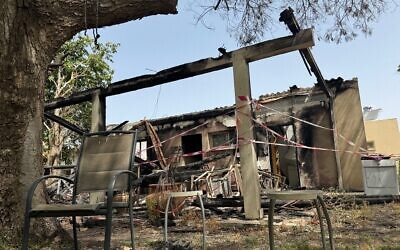
“I was so confused,” recalls Batia with a shudder. “At first, I thought Machmud must have heard about the attack and was calling out of concern. It didn’t take long to realise he had a different reason. He wanted to cause me harm. I didn’t speak to him. I just hung up. I didn’t have time to think about the call until two days later. Terrorists were everywhere. My husband and I were just trying to survive. Later, I gave all the details I had about Machmud to the army. His phone number, personal information he’d shared, screenshots of our chats. I have no idea what happened to him.”
Three hours before that chilling phone call, Batia and her husband Nahum awoke to the sound of rockets. Living mere metres from the border fence, Kfar Aza residents could gauge where Hamas missiles from Gaza were aimed based on the intensity of the launch.
“The first round sounded like a jet plane, so I knew they were heading for Tel Aviv,” Batia says. “I usually don’t run to the bomb shelter because those rockets pass over us. This time the number was so great we had to run for the safety of our bomb shelter.
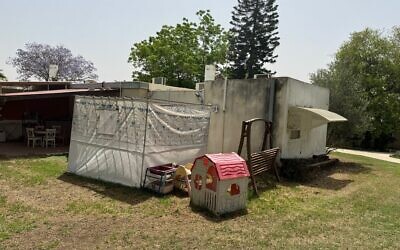
“On the way, I saw through my open kitchen window three people standing in our front garden, dressed in black with white bands around their heads, speaking Arabic. We quickly locked ourselves in the shelter, turned on the TV and saw terrorists in the town of Sderot, dressed exactly like the ones we’d just seen in our garden. If they had stood at a different angle they would have seen me in the kitchen and it would have ended differently.
“Hour after hour, messages flashed up on my phone from across the kibbutz. ‘Save us!’ ‘There are terrorists!’ ‘Where are the soldiers?’ There was no response. Nothing. We were alone.” The army eventually reached the scene of death and devastation 10 hours later, at 4.30pm.
I was so confused. At first, I thought Machmud must have heard about the attack and was calling out of concern. It didn’t take long to realise he had a different reason.
Batia and Nahum remained in their shelter without food or water for 26 hours, watching the attack on their street unfold on Batia’s phone via her car’s security camera. “We saw five terrorists on our roof and heard the endless sound of screams, gunshots and explosions. They went butchering from house to house.”
The couple were eventually evacuated to safety the next morning, but Batia’s nightmare was far from over as her daughter Rotem, son-in-law Assaf and two grandchildren also live on the kibbutz, in a house right next to the border fence where the terrorists invaded. Assaf was in hospital recovering from an accident that weekend, so Rotem and the children were home alone.
“We didn’t know what had happened to Rotem and the kids until we saw each other the next day. They survived being held captive in their house. Rotem pleaded with the terrorists. She said, ‘I am alone here with two kids’. They stayed a long time, eating, drinking, making a mess. They took Rotem’s phone and posted a picture of her and the children on social media.
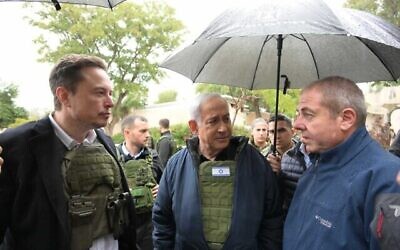
“Then they found a picture of Assaf and asked where he was. Rotem told them the truth, that he was in hospital, but they didn’t believe her and tore the house apart again looking for him. They took Rotem and the children to the family car to drive them into Gaza, but it had been badly damaged by bullet holes so didn’t start. Eventually they left without them. It wasn’t until around noon the next day that the army rescued them. Twenty of my daughter’s neighbours were murdered. Only one other family survived. Who knows why they didn’t kill my daughter and her children too.”
In a tragic twist of fate, a recent spate of gun thefts had led the kibbutz to store all personal weapons in a secure safe house, accessible only to the seven members of the community’s civil guard. All seven were shot dead as they tried to access the weapons to launch a counterattack.
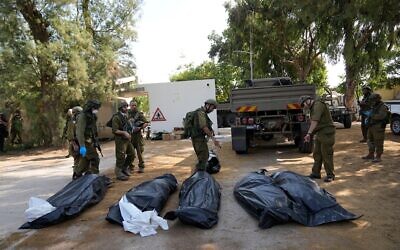
Sporadic fighting continued in Kfar Arza for the next four days, with the Israeli army going house to house and room by room until the last terrorist had been captured or killed. Then it was time to count the cost. In total, 64 residents had been slaughtered and 19 kidnapped and taken hostage.
Paint is daubed on the doors of every house that was attacked, a red number indicating how many bodies were found inside and a date in black marking when the property was cleared of human remains.
The Jewish festival of Succot ended the day before the attack. Kfar Aza’s succah, a temporary hut built for the week-long celebration, still stands beneath a giant sycamore tree. A doll’s house and a children’s slide sit on the grass nearby.
Sporadic fighting continued in Kfar Arza for the next four days, with the Israeli army going house to house and room by room until the last terrorist had been captured or killed. Then it was time to count the cost. In total, 64 residents had been slaughtered and 19 taken hostage.
Five residents are still among 116 hostages held in Gaza: twin brothers Ziv and Gali Berman, 26; Doron Steinbrecher, 30; Keith Siegel, 64; and Emily Damari, 27, a British-Israeli dual citizen. Their pictures are lovingly displayed across the kibbutz.
On 3 February 2024, exactly one year after Batia and Machmud’s exhibition, Batia, who is staying with family in Kibbutz Shefayim near Tel Aviv with fellow survivors from Kfar Aza, opened a second photography exhibition called The Dream And Its Break. It is in four parts, entitled The blackened present, Shattered dream, Garden of remembrance and Hope, let it be. “It tells the story of how my 50-year dream of peace was broken in a single day,” Batia says, her voice heavy with sorrow.
I ask if she will ever return. “I don’t know,” Batia sighs. “If my daughter doesn’t come back, I won’t. But there’s still time before we face these questions. First, we must see what happens with the hostages and what happens in Gaza. No one can live here until Hamas is gone. Before she was released, Hamas told one of the hostages taken from Kfar Aza, ‘Don’t go back because we will return.’ I believe them.”
Batia’s photography can be viewed HERE
• Richard visited Kfar Aza courtesy of the Jerusalem Press Club.
See: jerusalempressclub.com

Thank you for helping to make Jewish News the leading source of news and opinion for the UK Jewish community. Today we're asking for your invaluable help to continue putting our community first in everything we do.
For as little as £5 a month you can help sustain the vital work we do in celebrating and standing up for Jewish life in Britain.
Jewish News holds our community together and keeps us connected. Like a synagogue, it’s where people turn to feel part of something bigger. It also proudly shows the rest of Britain the vibrancy and rich culture of modern Jewish life.
You can make a quick and easy one-off or monthly contribution of £5, £10, £20 or any other sum you’re comfortable with.
100% of your donation will help us continue celebrating our community, in all its dynamic diversity...
Engaging
Being a community platform means so much more than producing a newspaper and website. One of our proudest roles is media partnering with our invaluable charities to amplify the outstanding work they do to help us all.
Celebrating
There’s no shortage of oys in the world but Jewish News takes every opportunity to celebrate the joys too, through projects like Night of Heroes, 40 Under 40 and other compelling countdowns that make the community kvell with pride.
Pioneering
In the first collaboration between media outlets from different faiths, Jewish News worked with British Muslim TV and Church Times to produce a list of young activists leading the way on interfaith understanding.
Campaigning
Royal Mail issued a stamp honouring Holocaust hero Sir Nicholas Winton after a Jewish News campaign attracted more than 100,000 backers. Jewish Newsalso produces special editions of the paper highlighting pressing issues including mental health and Holocaust remembrance.
Easy access
In an age when news is readily accessible, Jewish News provides high-quality content free online and offline, removing any financial barriers to connecting people.
Voice of our community to wider society
The Jewish News team regularly appears on TV, radio and on the pages of the national press to comment on stories about the Jewish community. Easy access to the paper on the streets of London also means Jewish News provides an invaluable window into the community for the country at large.
We hope you agree all this is worth preserving.

